Dystrophin in the Neonatal and Adult Rat Intestine
Abstract
1. Introduction
2. Materials and Methods
2.1. Animals
2.2. Western Blot
Western Blot Data Analysis
2.3. qPCR
qPCR Data Analysis
2.4. Immunohistochemistry
3. Results
3.1. Dp71 and aSMA Protein Expression in the Neonatal and Adult Rat Intestine
3.2. Gene Expression of Dp71 in the Neonatal and Adult Rat Intestine
3.3. Histological and Cellular Dystrophin Distribution in the Rat Intestine
4. Discussion
4.1. Dp71 and aSMA Expression in Neonatal and Adult Rats
4.2. Cellular Distribution of Dystrophin in the Rat Intestine
5. Conclusions
Author Contributions
Funding
Institutional Review Board Statement
Informed Consent Statement
Data Availability Statement
Acknowledgments
Conflicts of Interest
Abbreviations
| ActB | beta actin |
| aSMA | alpha-smooth muscle actin |
| CNS | central nervous system |
| DGC | dystrophin-glycoprotein complex |
| DMD | Duchenne muscular dystrophy |
| Dp | dystrophin protein |
| ENS | enteric nervous system |
| GAPDH | anti-glyceraldehyde-3-phosphate dehydrogenase |
| GI | gastrointestinal |
| Hprt | hypoxanthine phosphoribosyl transferase |
| HuC/HuD | Hu RNA binding protein C and D |
| PBS | Phosphate buffered saline |
| Tbp | TATA box binding protein |
| VIM | vimentin |
Appendix A. Polymerase Chain Reaction Protocol
Appendix B

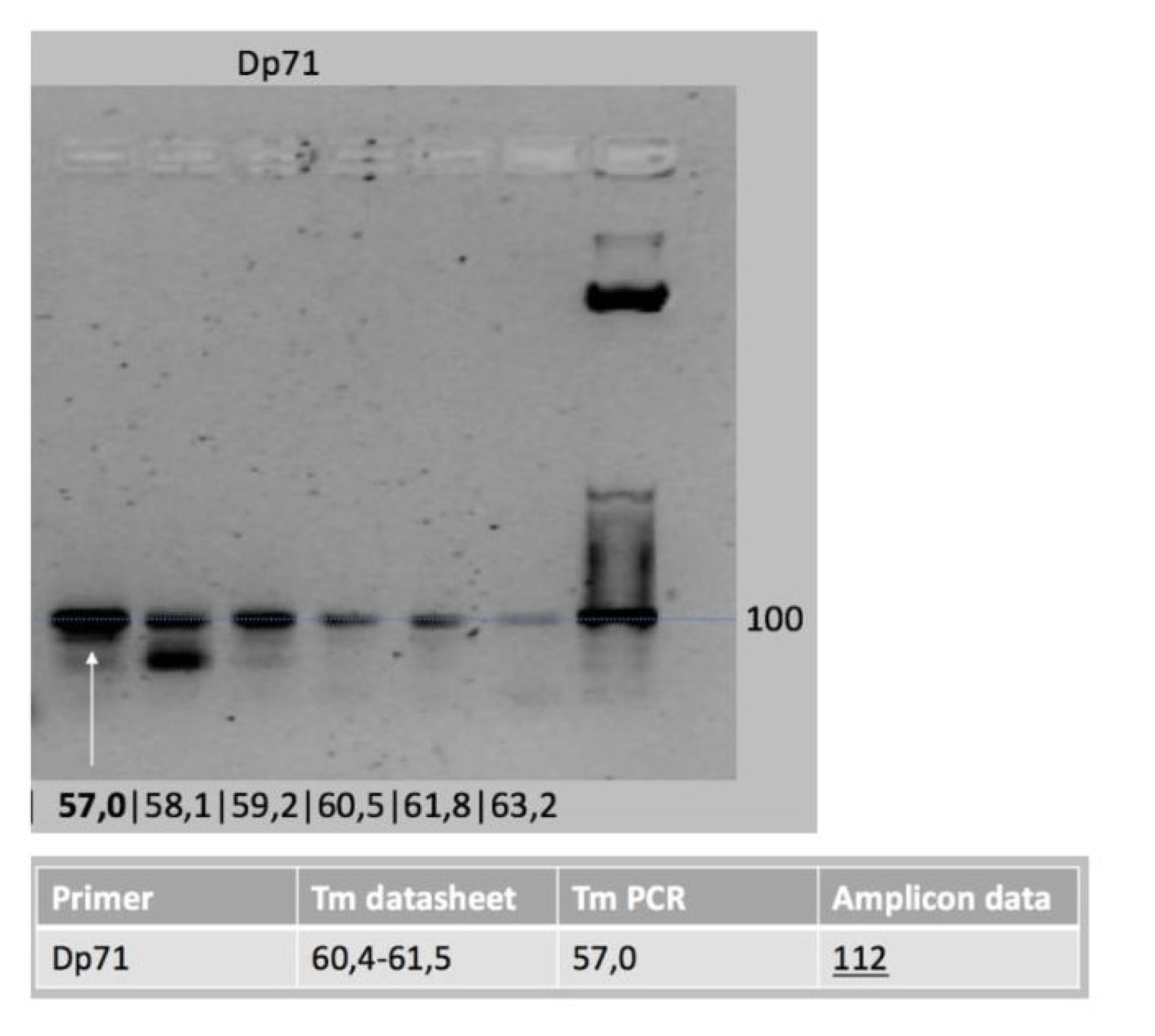
Appendix C
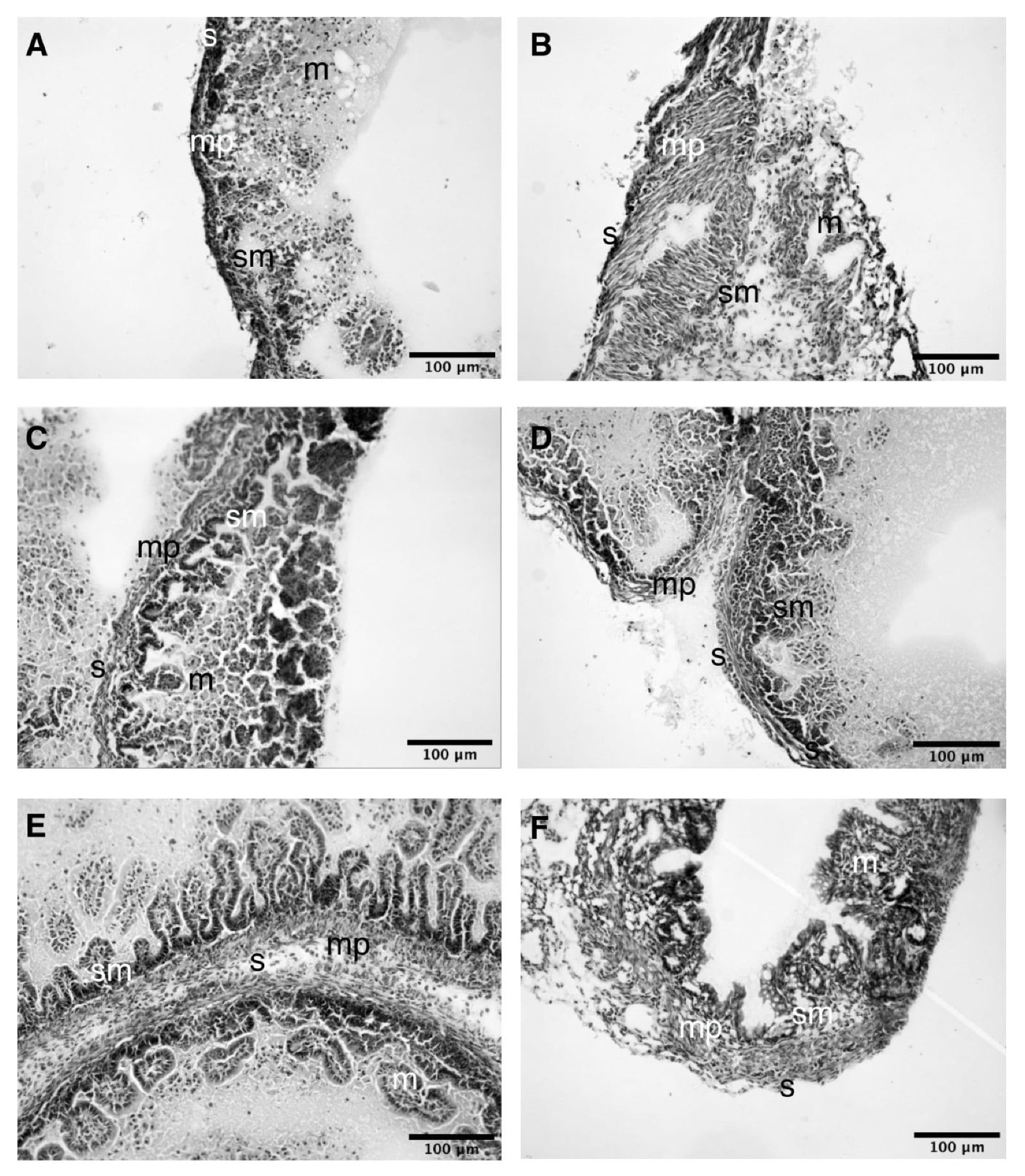
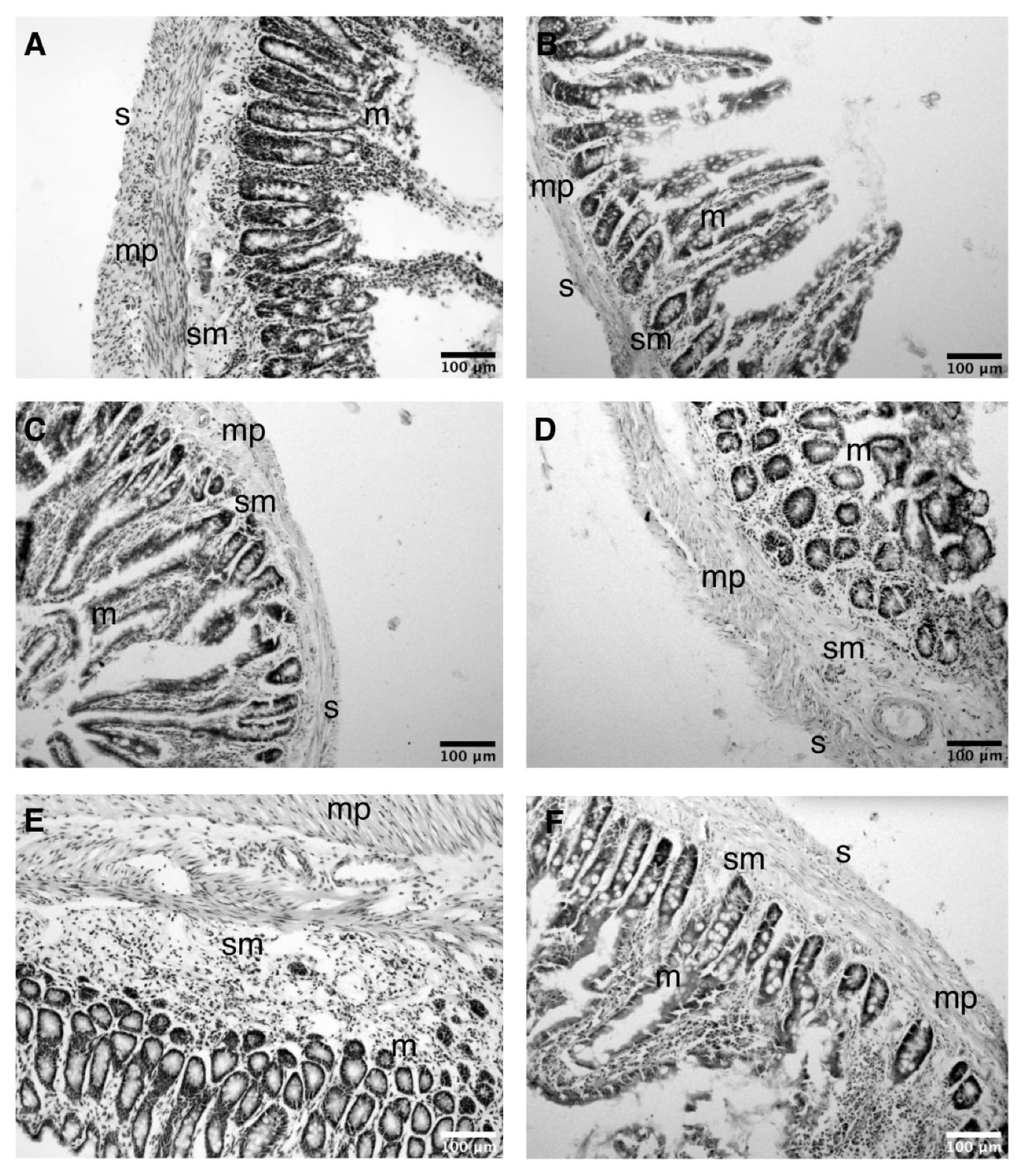
Appendix D
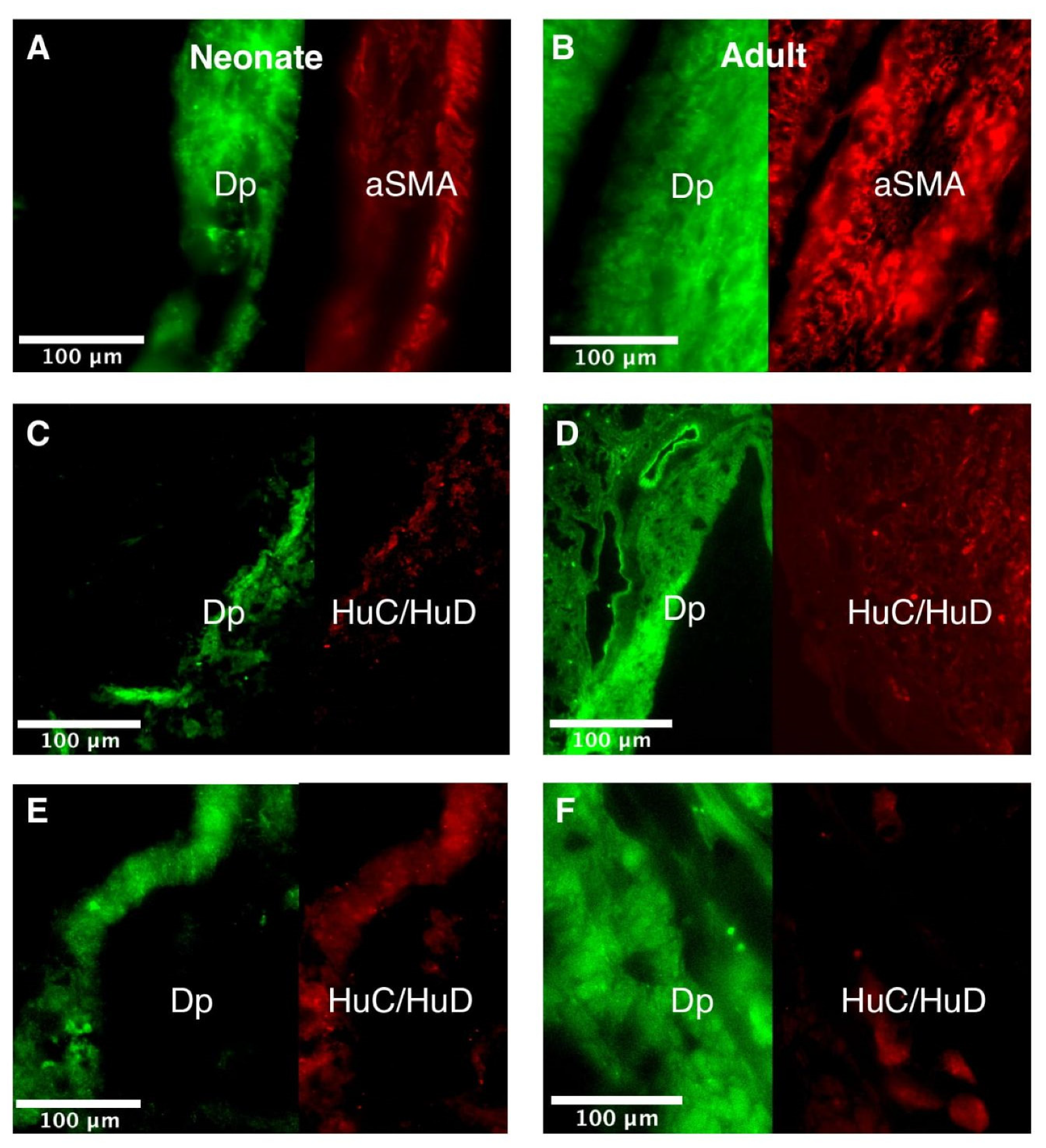
Appendix E
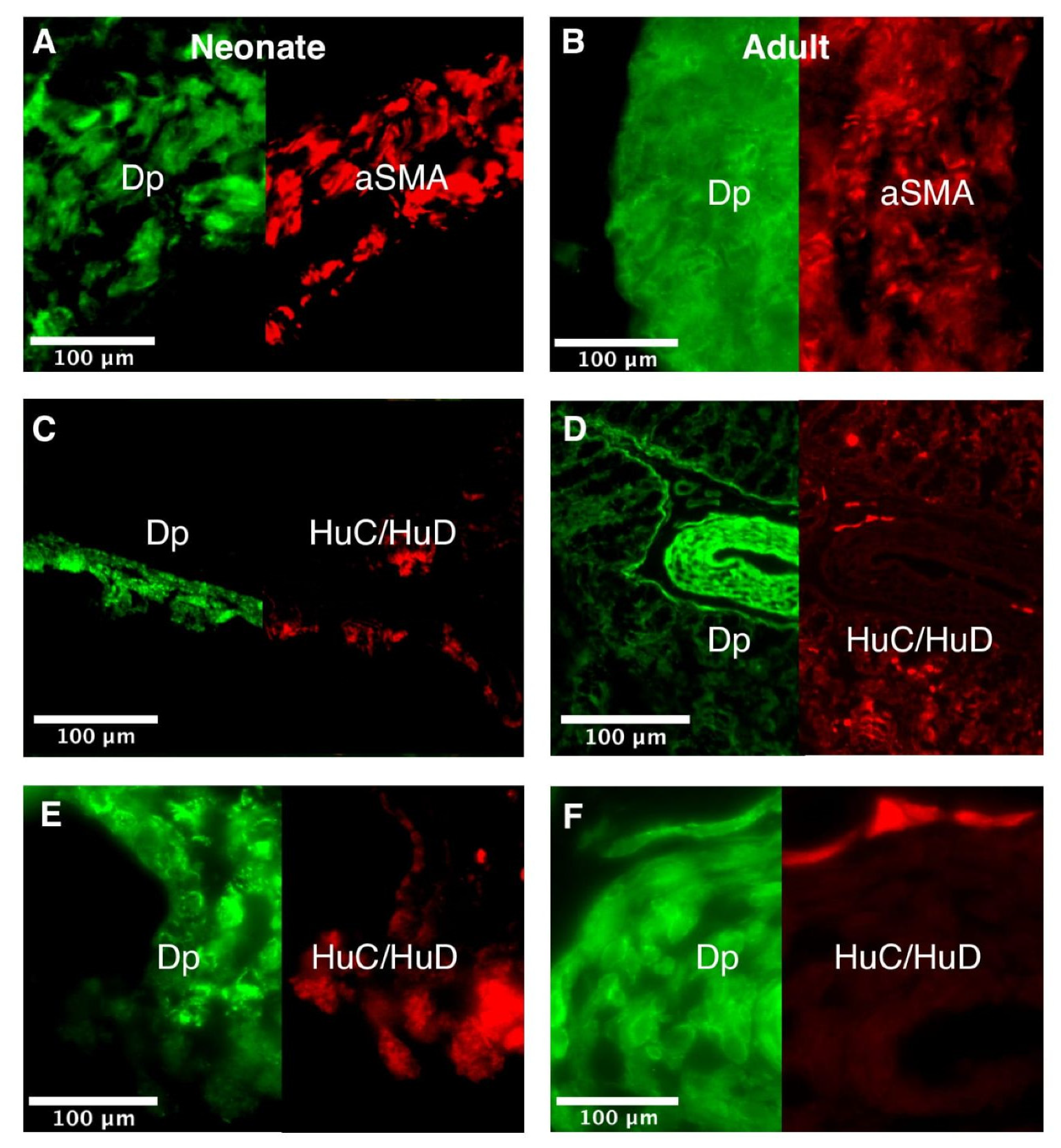
References
- Vainzof, M.; Zatz, M. Protein defects in neuromuscular diseases. Braz. J. Med. Biol. Res. 2003, 36, 543–555. [Google Scholar] [CrossRef][Green Version]
- Haenggi, T.; Fritschy, J.M. Role of dystrophin and utrophin for assembly and function of the dystrophin glycoprotein complex in non-muscle tissue. Cell. Mol. Life Sci. 2006, 63, 1614–1631. [Google Scholar] [CrossRef]
- Muntoni, F.; Torelli, S.; Ferlini, A. Dystrophin and mutations: One gene, several proteins, multiple phenotypes. Lancet Neurol. 2003, 2, 731–740. [Google Scholar] [CrossRef]
- Fujimoto, T.; Itoh, K.; Yaoi, T.; Fushiki, S. Somatodendritic and excitatory postsynaptic distribution of neuron-type dystrophin isoform, Dp40, in hippocampal neurons. Biochem. Biophys. Res. Commun. 2014, 452, 79–84. [Google Scholar] [CrossRef]
- Lionarons, J.M.; Hoogland, G.; Hendriksen, R.G.F.; Faber, C.G.; Hellebrekers, D.M.J.; Van Koeveringe, G.A.; Schipper, S.; Vles, J.S.H. Dystrophin is expressed in smooth muscle and afferent nerve fibers in the rat urinary bladder. Muscle Nerve 2019, 60, 202–210. [Google Scholar] [CrossRef]
- Tome, F.M.; Matsumura, K.; Chevallay, M.; Campbell, K.P.; Fardeau, M. Expression of dystrophin-associated glycoproteins during human fetal muscle development: A preliminary immunocytochemical study. Neuromuscul. Disord. 1994, 4, 343–348. [Google Scholar] [CrossRef]
- Sarig, R.; Mezger-Lallemand, V.; Gitelman, I.; Davis, C.; Fuchs, O.; Yaffe, D.; Nudel, U. Targeted inactivation of Dp71, the major non-muscle product of the DMD gene: Differential activity of the Dp71 promoter during development. Hum. Mol. Genet. 1999, 8, 1–10. [Google Scholar] [CrossRef]
- Sogos, V.; Curto, M.; Reali, C.; Gremo, F. Developmentally regulated expression and localization of dystrophin and utrophin in the human fetal brain. Mech. Ageing Dev. 2002, 123, 455–462. [Google Scholar] [CrossRef]
- Lunde, L.K.; Camassa, L.M.; Hoddevik, E.H.; Khan, F.H.; Ottersen, O.P.; Boldt, H.B.; Amiry-Moghaddam, M. Postnatal development of the molecular complex underlying astrocyte polarization. Brain Struct. Funct. 2015, 220, 2087–2101. [Google Scholar] [CrossRef]
- Archer, S.K.; Garrod, R.; Hart, N.; Miller, S. Dysphagia in Duchenne muscular dystrophy assessed by validated questionnaire. Int. J. Lang. Commun. Disord. 2013, 48, 240–246. [Google Scholar] [CrossRef]
- Archer, S.K.; Garrod, R.; Hart, N.; Miller, S. Dysphagia in Duchenne muscular dystrophy assessed objectively by surface electromyography. Dysphagia 2013, 28, 188–198. [Google Scholar] [CrossRef]
- Lo Cascio, C.M.; Goetze, O.; Latshang, T.D.; Bluemel, S.; Frauenfelder, T.; Bloch, K.E. Gastrointestinal Dysfunction in Patients with Duchenne Muscular Dystrophy. PLoS ONE 2016, 11, e0163779. [Google Scholar] [CrossRef]
- Kraus, D.; Wong, B.L.; Horn, P.S.; Kaul, A. Constipation in Duchenne Muscular Dystrophy: Prevalence, Diagnosis, and Treatment. J. Pediatr. 2016, 171, 183–188. [Google Scholar] [CrossRef]
- Pangalila, R. Quality of life in Duchenne muscular dystrophy: The disability paradox. Dev. Med. Child Neurol. 2016, 58, 435–436. [Google Scholar] [CrossRef] [PubMed]
- Camilleri, M. Disorders of Gastrointestinal Motility in Neurologie Diseases; Elsevier: Amsterdam, The Netherlands, 1990; pp. 825–846. [Google Scholar]
- Bellini, M.; Biagi, S.; Stasi, C.; Costa, F.; Mumolo, M.G.; Ricchiuti, A.; Marchi, S. Gastrointestinal manifestations in myotonic muscular dystrophy. World J. Gastroenterol. WJG 2006, 12, 1821. [Google Scholar] [CrossRef]
- Crockett, C.D.; Bertrand, L.A.; Cooper, C.S.; Rahhal, R.M.; Liu, K.; Zimmerman, M.B.; Moore, S.A.; Mathews, K.D. Urologic and gastrointestinal symptoms in the dystroglycanopathies. Neurology 2015, 84, 532–539. [Google Scholar] [CrossRef]
- Vannucchi, M.-G.; Zardo, C.; Corsani, L.; Faussone-Pellegrini, M.-S. Interstitial cells of Cajal, enteric neurons, and smooth muscle and myoid cells of the murine gastrointestinal tract express full-length dystrophin. Histochem. Cell Biol. 2002, 118, 449–457. [Google Scholar] [CrossRef]
- Turczynska, K.M.; Sward, K.; Hien, T.T.; Wohlfahrt, J.; Mattisson, I.Y.; Ekman, M.; Nilsson, J.; Sjögren, J.; Murugesan, V.; Hultgårdh-Nilsson, A.; et al. Regulation of smooth muscle dystrophin and synaptopodin 2 expression by actin polymerization and vascular injury. Arter. Thromb Vasc. Biol. 2015, 35, 1489–1497. [Google Scholar] [CrossRef]
- Vannucchi, M.G.; Corsani, L.; Giovannini, M.G.; Faussone-Pellegrini, M.S. Expression of dystrophin in the mouse myenteric neurones. Neurosci. Lett. 2001, 300, 120–124. [Google Scholar] [CrossRef]
- Tokarz, S.A.; Duncan, N.M.; Rash, S.M.; Sadeghi, A.; Dewan, A.K.; Pillers, D.A. Redefinition of dystrophin isoform distribution in mouse tissue by RT-PCR implies role in nonmuscle manifestations of duchenne muscular dystrophy. Mol. Genet. Metab. 1998, 65, 272–281. [Google Scholar] [CrossRef] [PubMed]
- Mochizuki, K.; Yorita, S.; Goda, T. Gene expression changes in the jejunum of rats during the transient suckling-weaning period. J. Nutr. Sci. Vitam 2009, 55, 139–148. [Google Scholar] [CrossRef][Green Version]
- Schafer, K.H.; Hansgen, A.; Mestres, P. Morphological changes of the myenteric plexus during early postnatal development of the rat. Anat. Rec. 1999, 256, 20–28. [Google Scholar] [CrossRef]
- Hendriksen, R.G.; Schipper, S.; Hoogland, G.; Schijns, O.E.; Dings, J.T.; Aalbers, M.W.; Vles, J.S.H. Dystrophin Distribution and Expression in Human and Experimental Temporal Lobe Epilepsy. Front. Cell. Neurosci. 2016, 10, 174. [Google Scholar] [CrossRef]
- Anthony, K.; Arechavala-Gomeza, V.; Taylor, L.E.; Vulin, A.; Kaminoh, Y.; Torelli, S.; Feng, L.; Janghra, N.; Bonne, G.; Beuvin, M.; et al. Dystrophin quantification: Biological and translational research implications. Neurology 2014, 83, 2062–2069. [Google Scholar] [CrossRef]
- Bradford, M.M. A rapid and sensitive method for the quantitation of microgram quantities of protein utilizing the principle of protein-dye binding. Anal. Biochem. 1976, 72, 248–254. [Google Scholar] [CrossRef]
- Cooper, S.T.; Lo, H.P.; North, K.N. Single section Western blot: Improving the molecular diagnosis of the muscular dystrophies. Neurology 2003, 61, 93–97. [Google Scholar] [CrossRef] [PubMed]
- Taylor, S.C.; Berkelman, T.; Yadav, G.; Hammond, M. A defined methodology for reliable quantification of Western blot data. Mol. Biotechnol. 2013, 55, 217–226. [Google Scholar] [CrossRef] [PubMed]
- Ye, J.; Coulouris, G.; Zaretskaya, I.; Cutcutache, I.; Rozen, S.; Madden, T.L. Primer-BLAST: A tool to design target-specific primers for polymerase chain reaction. BMC Bioinform. 2012, 13, 134. [Google Scholar] [CrossRef]
- Grootjans, J.; Hodin, C.M.; de Haan, J.J.; Derikx, J.P.; Rouschop, K.M.; Verheyen, F.K.; van Dam, R.M.; Dejong, C.H.C.; Buurman, W.A.; Lenaerts, K. Level of activation of the unfolded protein response correlates with Paneth cell apoptosis in human small intestine exposed to ischemia/reperfusion. Gastroenterology 2011, 140, 529–539.e523. [Google Scholar] [CrossRef]
- Martinez-Beamonte, R.; Navarro, M.A.; Larraga, A.; Strunk, M.; Barranquero, C.; Acin, S.; Guzman, M.A.; Iñigo, P.; Osada, J. Selection of reference genes for gene expression studies in rats. J. Biotechnol. 2011, 151, 325–334. [Google Scholar] [CrossRef]
- Andersen, C.L.; Jensen, J.L.; Orntoft, T.F. Normalization of real-time quantitative reverse transcription-PCR data: A model-based variance estimation approach to identify genes suited for normalization, applied to bladder and colon cancer data sets. Cancer Res. 2004, 64, 5245–5250. [Google Scholar] [CrossRef] [PubMed]
- Bustin, S.A.; Benes, V.; Garson, J.A.; Hellemans, J.; Huggett, J.; Kubista, M.; Mueller, R.; Nolan, T.; Pfaffl, M.W.; Shipley, G.L.; et al. The MIQE guidelines: Minimum information for publication of quantitative real-time PCR experiments. Clin. Chem. 2009, 55, 611–622. [Google Scholar] [CrossRef]
- Schmittgen, T.D.; Livak, K.J. Analyzing real-time PCR data by the comparative C T method. Nat. Protoc. 2008, 3, 1101. [Google Scholar] [CrossRef]
- Zhang, S.-X. Digestive System. In An Atlas of Histology; Springer: New York, NY, USA, 1999; pp. 187–251. [Google Scholar]
- Vaes, N.; Lentjes, M.H.F.M.; Gijbels, M.J.; Rademakers, G.; Daenen, K.L.; Boesmans, W.; Wouters, K.A.D.; Geuzens, A.; Qu, X.; Steinbusch, H.P.J.; et al. NDRG4, an early detection marker for colorectal cancer, is specifically expressed in enteric neurons. Neurogastroenterol. Motil 2017, 29, e13095. [Google Scholar] [CrossRef] [PubMed]
- Singh, S.; Mandal, M.B.; Patne, S.C.; Pandey, R. Histological characteristics of colon and rectum of adults and neonate rats. Natl. J. Physiol. Pharm. Pharmacol. 2017, 7, 891. [Google Scholar] [CrossRef]
- Burns, A.J.; Roberts, R.R.; Bornstein, J.C.; Young, H.M. Development of the enteric nervous system and its role in intestinal motility during fetal and early postnatal stages. Semin. Pediatr. Surg. 2009, 18, 196–205. [Google Scholar] [CrossRef] [PubMed]
- Ogobuiro, I.; Tuma, F. Physiology, Gastrointestinal; StatPearls: Treasure Island, FL, USA, 2019. [Google Scholar]
- Chaudry, G.; Navarro, O.M.; Levine, D.S.; Oudjhane, K. Abdominal manifestations of cystic fibrosis in children. Pediatric. Radiol. 2006, 36, 233–240. [Google Scholar] [CrossRef] [PubMed]
- Vogel, C.; Marcotte, E.M. Insights into the regulation of protein abundance from proteomic and transcriptomic analyses. Nat. Rev. Genet. 2012, 13, 227–232. [Google Scholar] [CrossRef]
- Schwanhäusser, B.; Busse, D.; Li, N.; Dittmar, G.; Schuchhardt, J.; Wolf, J.; Chen, W.; Selbach, M. Global quantification of mammalian gene expression control. Nature 2011, 473, 337–342. [Google Scholar] [CrossRef]
- Sharova, L.V.; Sharov, A.A.; Nedorezov, T.; Piao, Y.; Shaik, N.; Ko, M.S. Database for mRNA half-life of 19 977 genes obtained by DNA microarray analysis of pluripotent and differentiating mouse embryonic stem cells. DNA Res. 2009, 16, 45–58. [Google Scholar] [CrossRef]
- Burns, A.J.; Pachnis, V. Development of the enteric nervous system: Bringing together cells, signals and genes. Neurogastroenterol. Motil. 2009, 21, 100–102. [Google Scholar] [CrossRef] [PubMed]
- Benvenuti, L.; D’Antongiovanni, V.; Pellegrini, C.; Antonioli, L.; Bernardini, N.; Blandizzi, C.; Fornai, M. Enteric Glia at the Crossroads between Intestinal Immune System and Epithelial Barrier: Implications for Parkinson Disease. Int. J. Mol. Sci. 2020, 21, 9199. [Google Scholar] [CrossRef] [PubMed]
- Tanaka, H.; Hijikata, T.; Murakami, T.; Fujimaki, N.; Ishikawa, H. Localization of plectin and other related proteins along the sarcolemma in smooth muscle cells of rat colon. Cell Struct. Funct. 2001, 26, 61–70. [Google Scholar] [CrossRef] [PubMed][Green Version]
- Sharma, P.; Basu, S.; Mitchell, R.W.; Stelmack, G.L.; Anderson, J.E.; Halayko, A.J. Role of dystrophin in airway smooth muscle phenotype, contraction and lung function. PLoS ONE 2014, 9, e102737. [Google Scholar] [CrossRef]

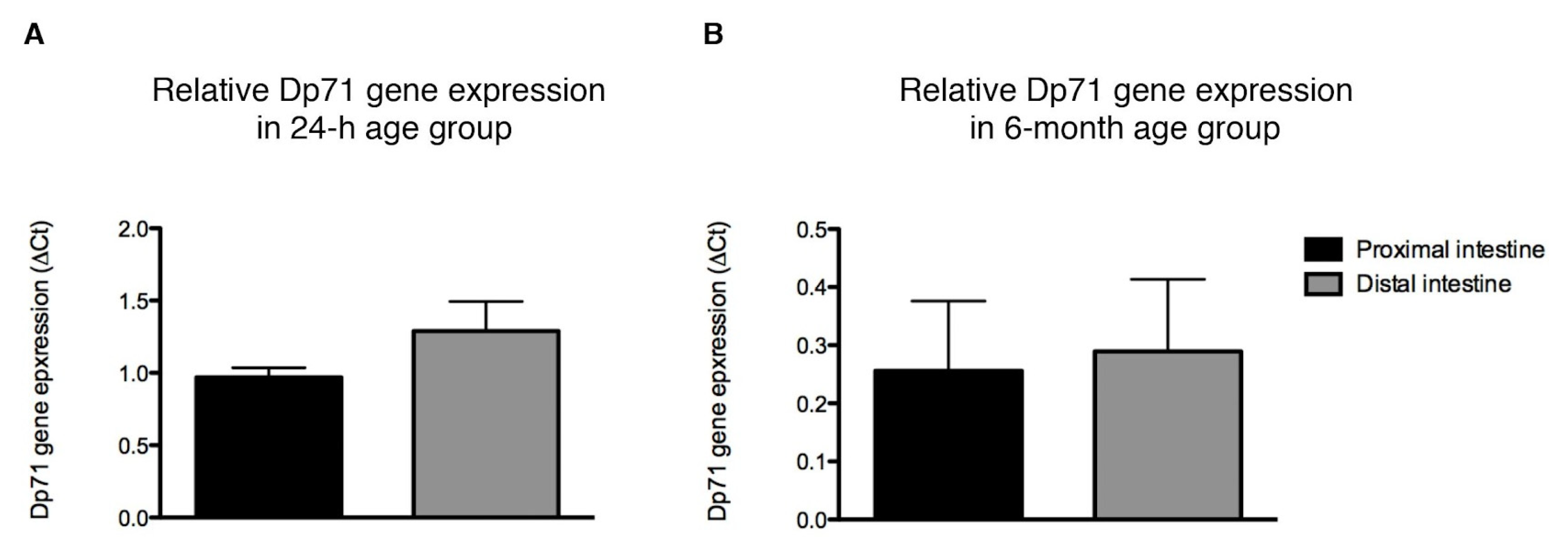
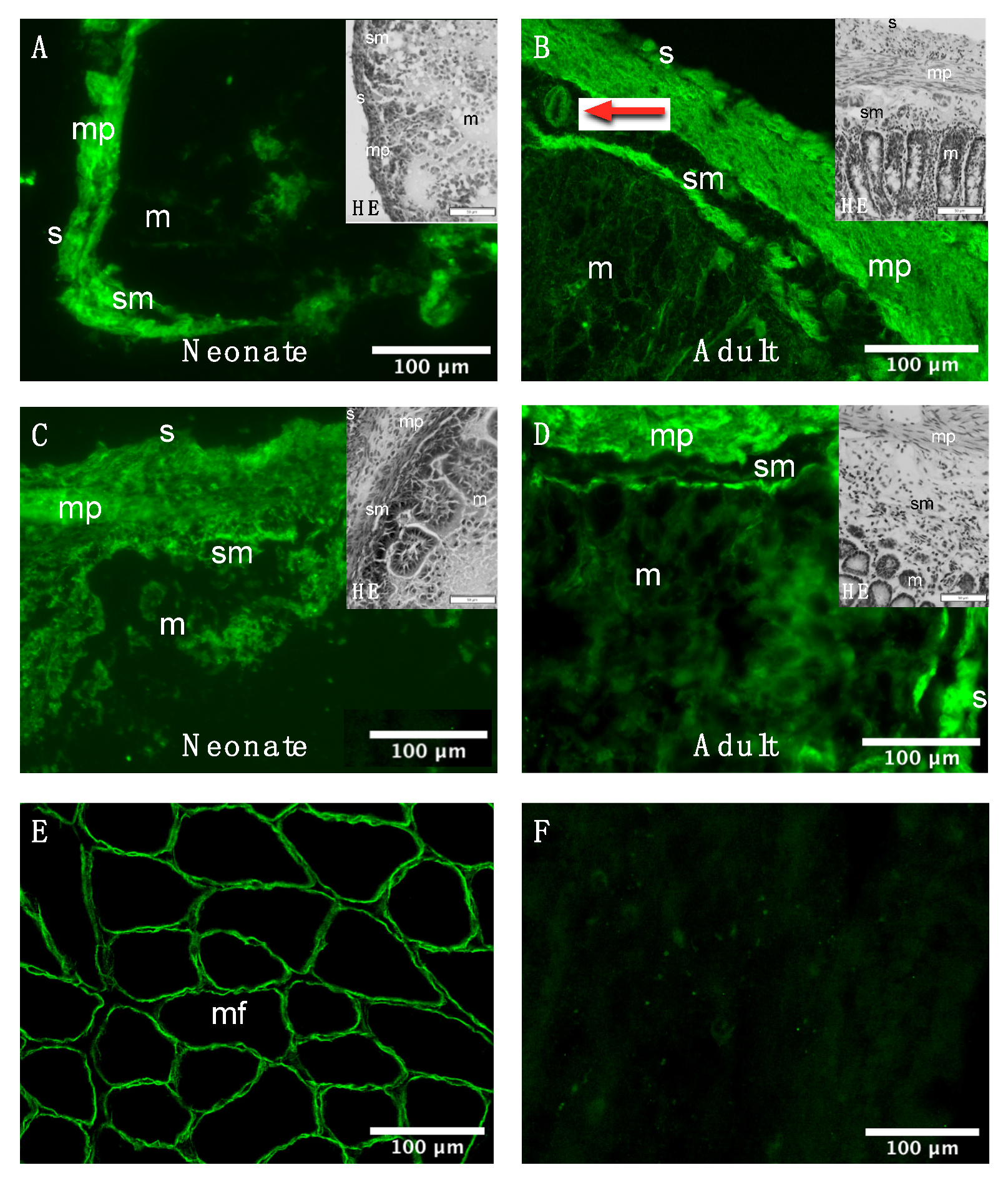
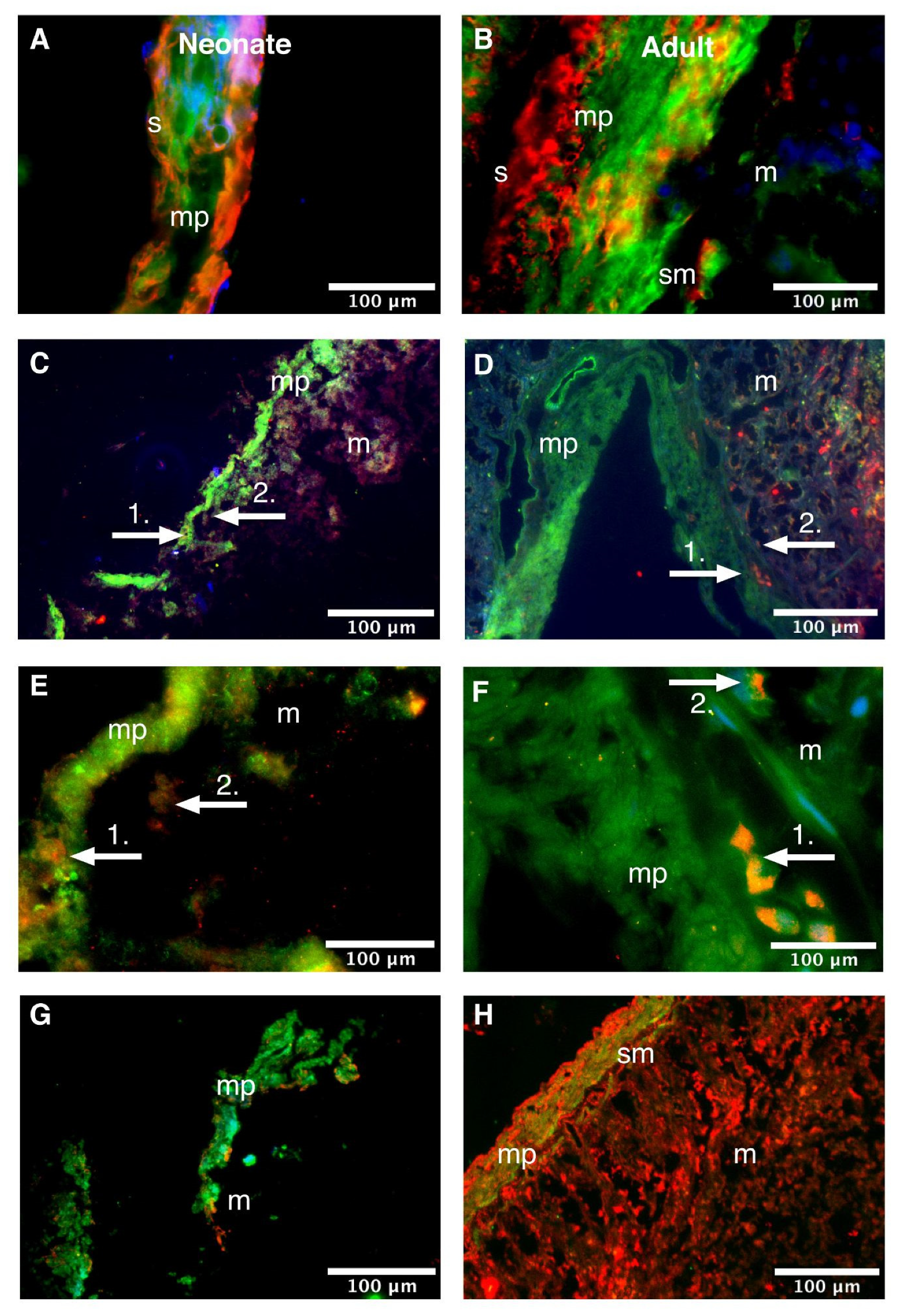
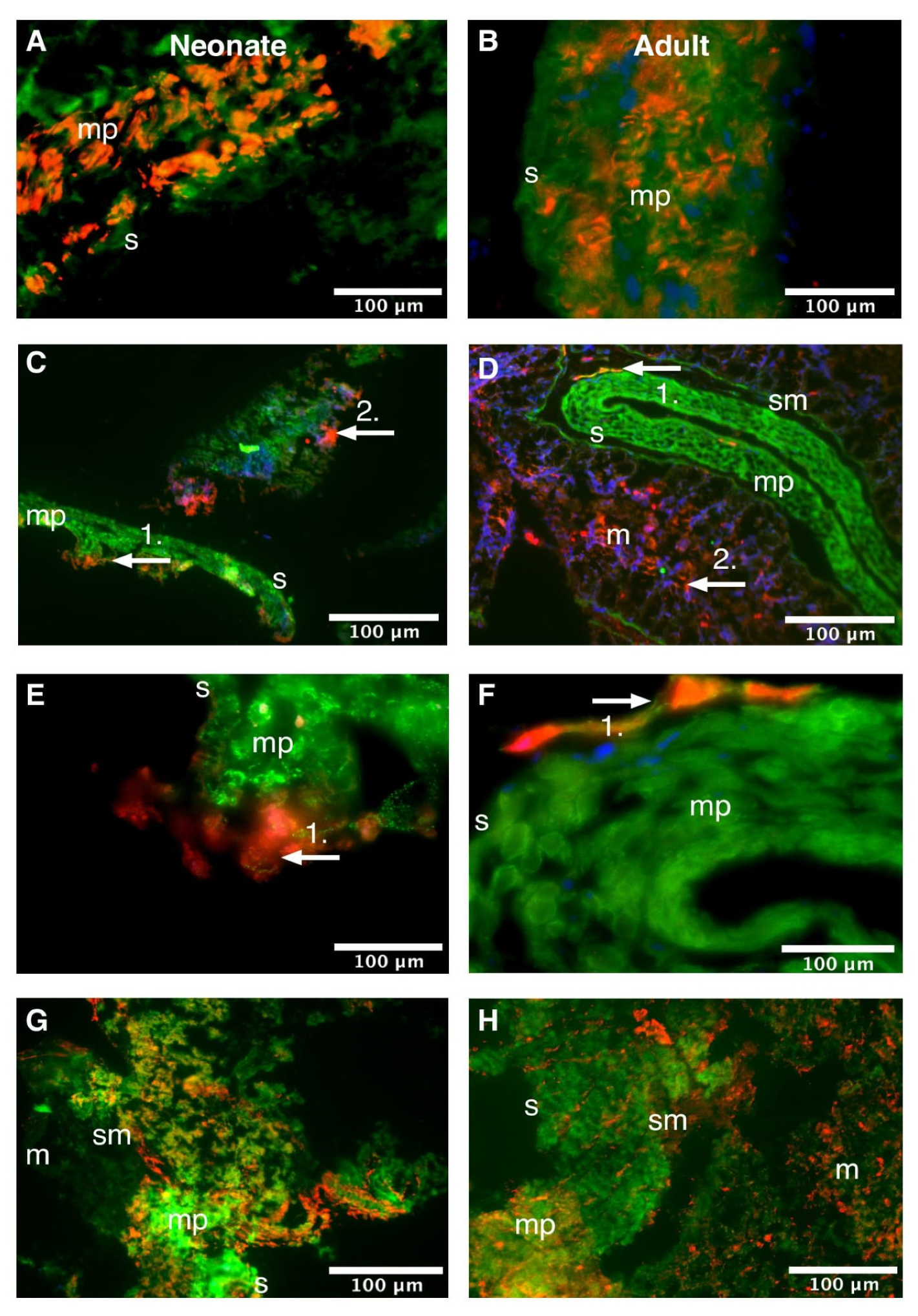
| Gene Symbol | Gene Function | Primer Sequence (5′ → 3′) | Amplicon Length (bp) |
|---|---|---|---|
| ActB | Cytoskeletal structural protein | F: AGAGGGAAATCGTGCGTGAC R: CGATAGTGATGACCTGACCGT | 86 |
| Hprt | Purinergic enzyme | F: AAGAGCTACTGTAATGACCA R: GTATCCAACACTTCGAGG | 152 |
| Tbp | General transcription factor | F: TAATCCCAAGCGGTTTGCTG R: TTCTTCACTCTTGGCTCCTGTG | 111 |
| Dp71 | Dystrophin protein isoform 71 kDa | F: ACAAGCACAGGGTTAGAAGAA R: AGGCTTCCTACATTGTGTCCT | 112 |
Publisher’s Note: MDPI stays neutral with regard to jurisdictional claims in published maps and institutional affiliations. |
© 2021 by the authors. Licensee MDPI, Basel, Switzerland. This article is an open access article distributed under the terms and conditions of the Creative Commons Attribution (CC BY) license (https://creativecommons.org/licenses/by/4.0/).
Share and Cite
Lionarons, J.M.; Hoogland, G.; Slegers, R.J.; Steinbusch, H.; Claessen, S.M.H.; Vles, J.S.H. Dystrophin in the Neonatal and Adult Rat Intestine. Life 2021, 11, 1155. https://doi.org/10.3390/life11111155
Lionarons JM, Hoogland G, Slegers RJ, Steinbusch H, Claessen SMH, Vles JSH. Dystrophin in the Neonatal and Adult Rat Intestine. Life. 2021; 11(11):1155. https://doi.org/10.3390/life11111155
Chicago/Turabian StyleLionarons, Judith M., Govert Hoogland, Rutger J. Slegers, Hellen Steinbusch, Sandra M. H. Claessen, and Johan S. H. Vles. 2021. "Dystrophin in the Neonatal and Adult Rat Intestine" Life 11, no. 11: 1155. https://doi.org/10.3390/life11111155
APA StyleLionarons, J. M., Hoogland, G., Slegers, R. J., Steinbusch, H., Claessen, S. M. H., & Vles, J. S. H. (2021). Dystrophin in the Neonatal and Adult Rat Intestine. Life, 11(11), 1155. https://doi.org/10.3390/life11111155






